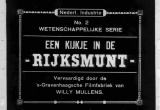Filmfabriek Hollandia and the Dutch School Film
On 8 November 1912, the first Dutch school film was presented in the Friso Bioscoop in Leeuwarden: Ontginning van woesten grond door de Nederlandsche Heidemaatschappij op het landgoed ‘de Utrecht’ te Hilvarenbeek.
Kinematograaf Pathé Frères made this film depicting the reclamation of Dutch heathlands. Beginning with shots of turf cutters from Brabant and ending with scenes of new pine trees being planted, everything is meticulously depicted (though unfortunately not always in focus). This gave schoolteachers showing the film plenty of time to explain what was happening on screen. After this heathlands film, five other short films were screened: one about the difference between water and ice, one about two nightingales who raise a young cuckoo, one about a diver, one about apes that escaped from a zoo, and, finally, Roodkapje (Red Riding Hood).
A reason to begin
In an interview a few years later, Maurits H. Binger, a film producer from Haarlem, said that the discussion around the cinema and school films was the reason he founded Filmfabriek Hollandia and started to make documentaries. In May 1912, the Maatschappij voor Wetenschappelijke Cinematografie and the Maatschappij voor Artistieke Cinematografie were established. Binger was the delegated commissioner for both of these companies, and the primary moving force behind the scenes, both financially as well as artistically. Later, both companies merged with Filmfabriek Hollandia, the most important producer of long feature films in the 1910s.
In Hollandia’s early years, it was primarily its documentary department that was most active, and it made many films on subjects such as the harbour industry in Amsterdam and Rotterdam, the fisheries in Volendam, and the construction of a pontoon bridge across the Rhine in Alphen aan den Rijn.
Up until WWI, these short documentaries formed the bulk of what Binger’s company produced. Every one of these films was also suitable for schoolchildren and (....) shown during school programmes.
Setting a good example
In the years that followed, other Dutch companies started making school films too. The most important of these was Willy Mullens’ company Haghe Film – who made his famous film Het leven der bijen in 1917 – and the Filmfabriek Polygoon from Haarlem, which was founded in 1919. Starting in the early 1920s, Polygoon produced a number of long documentaries that were made especially for school cinemas. For the most part, however, school films were made by foreign film companies.
more information
If you are looking for more material from our collection, please contact Film Sales:
sales@eyefilm.nl
phone +31 (0)20 5891 426

